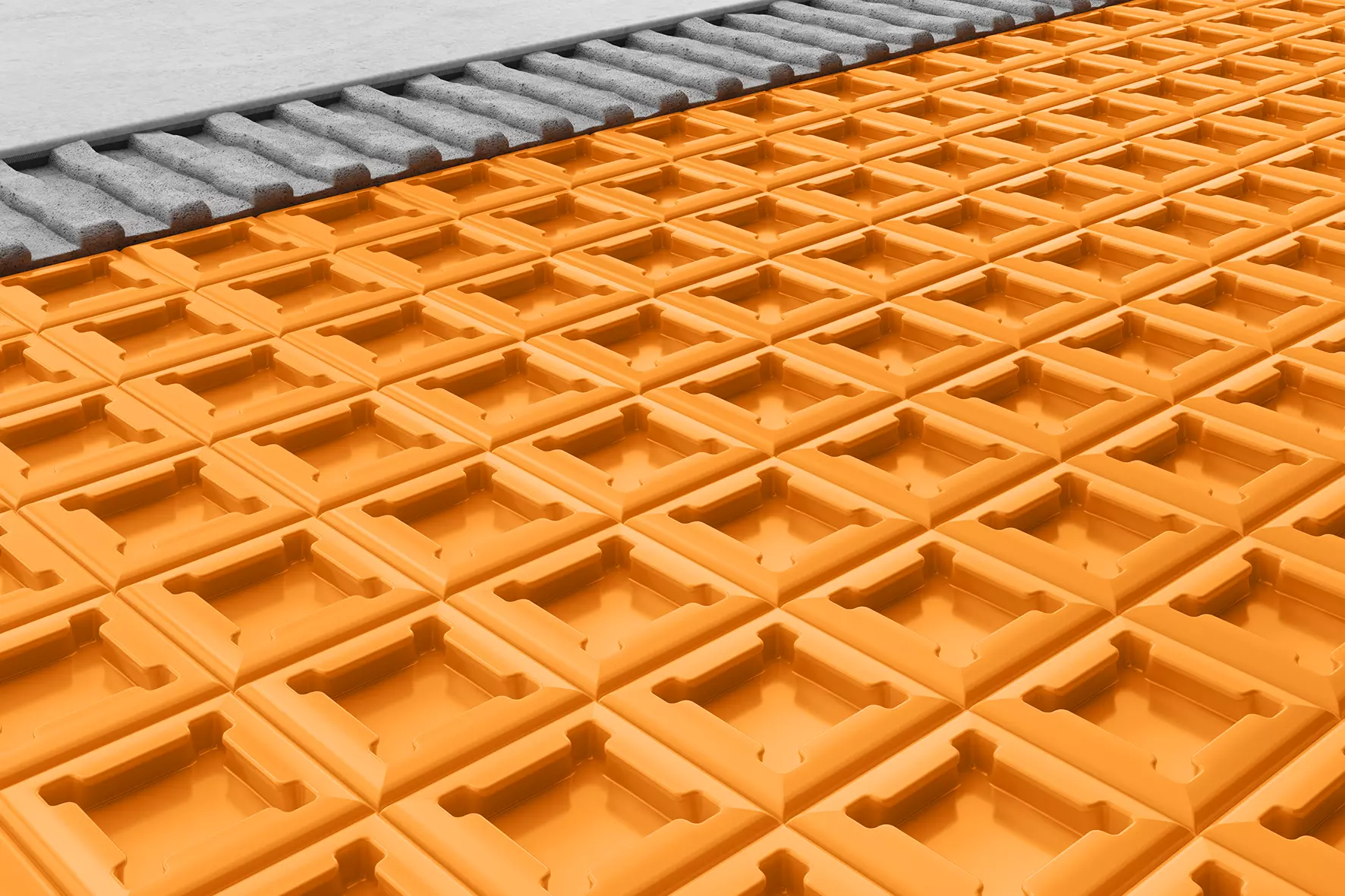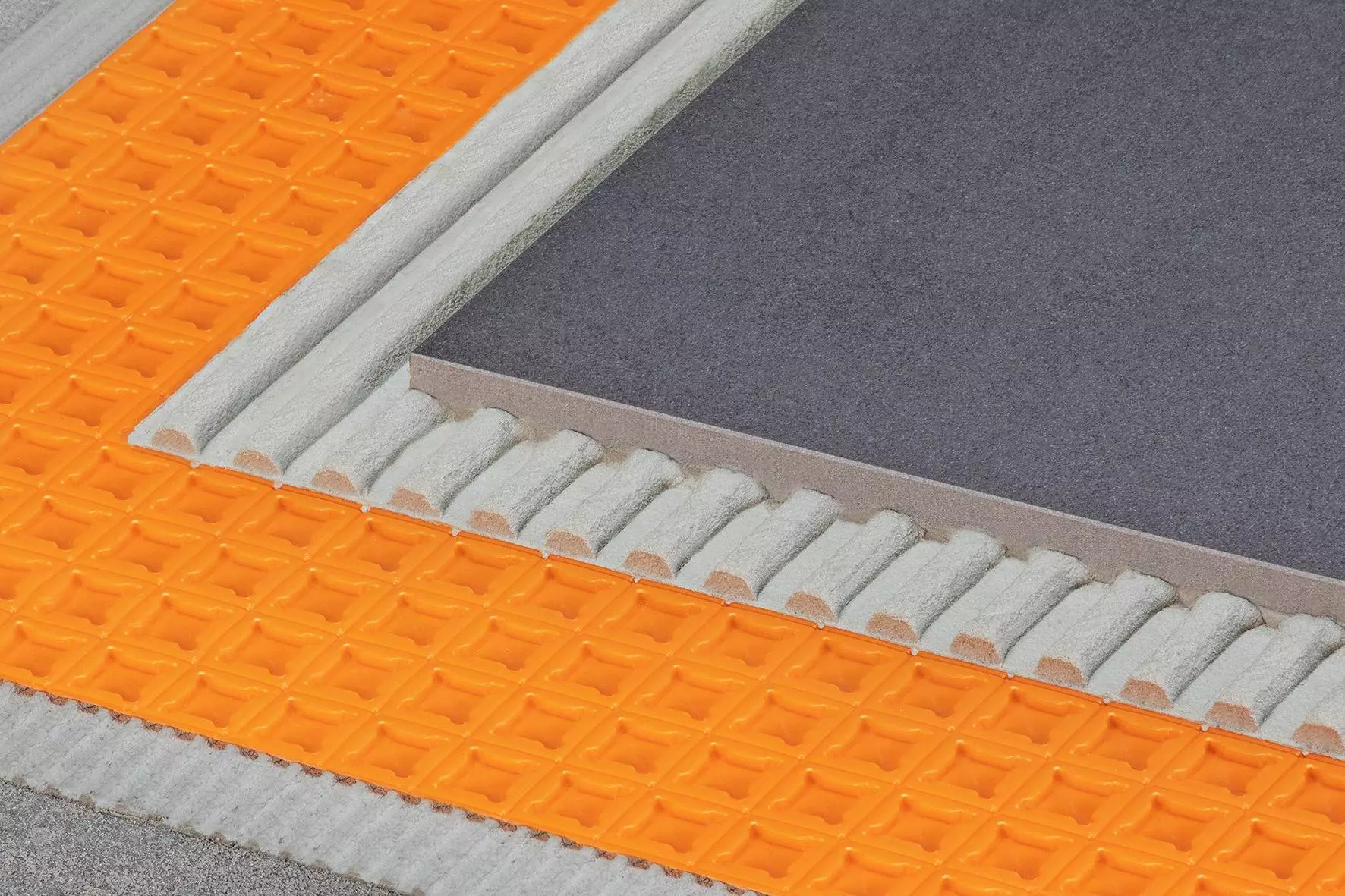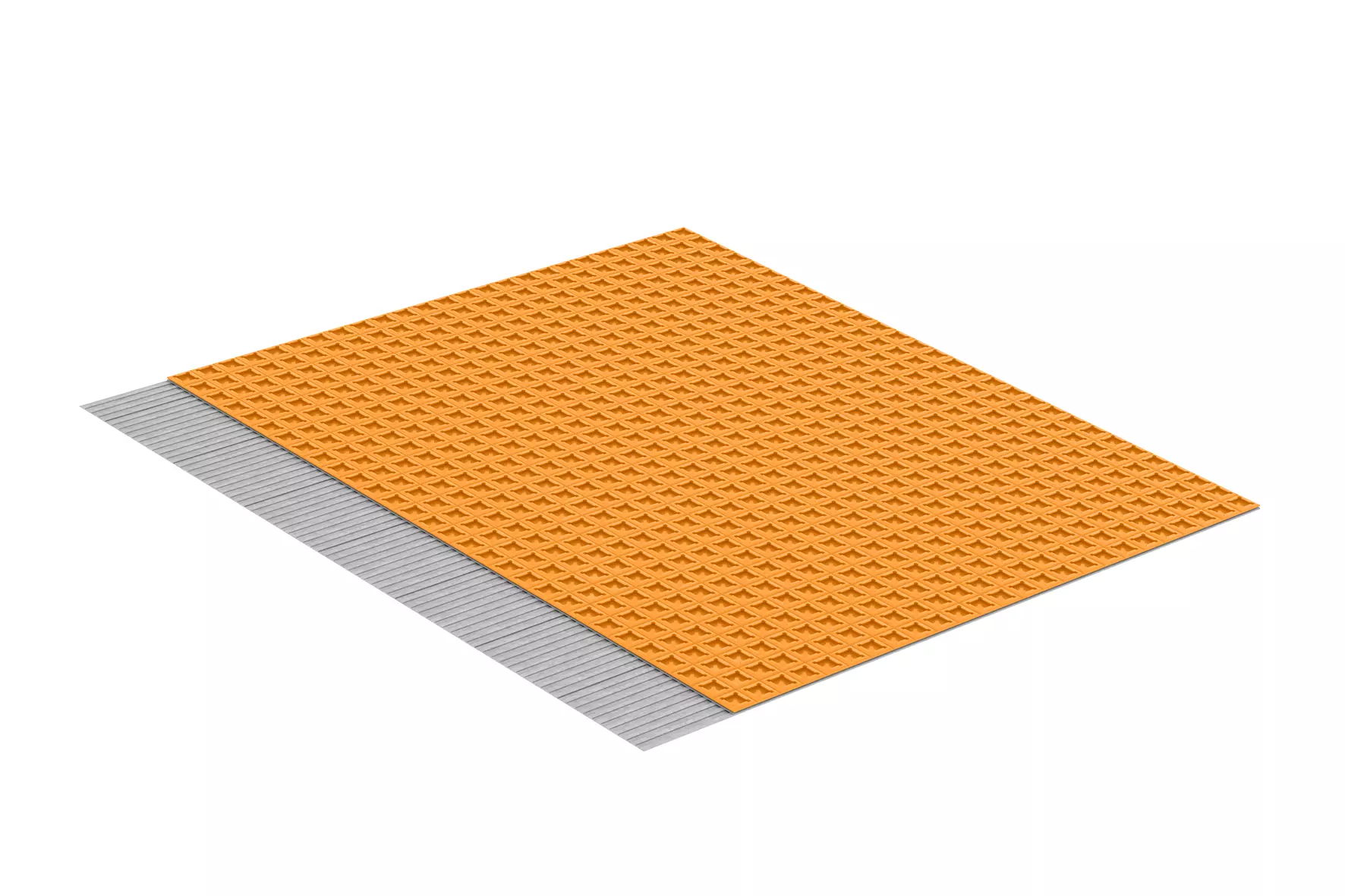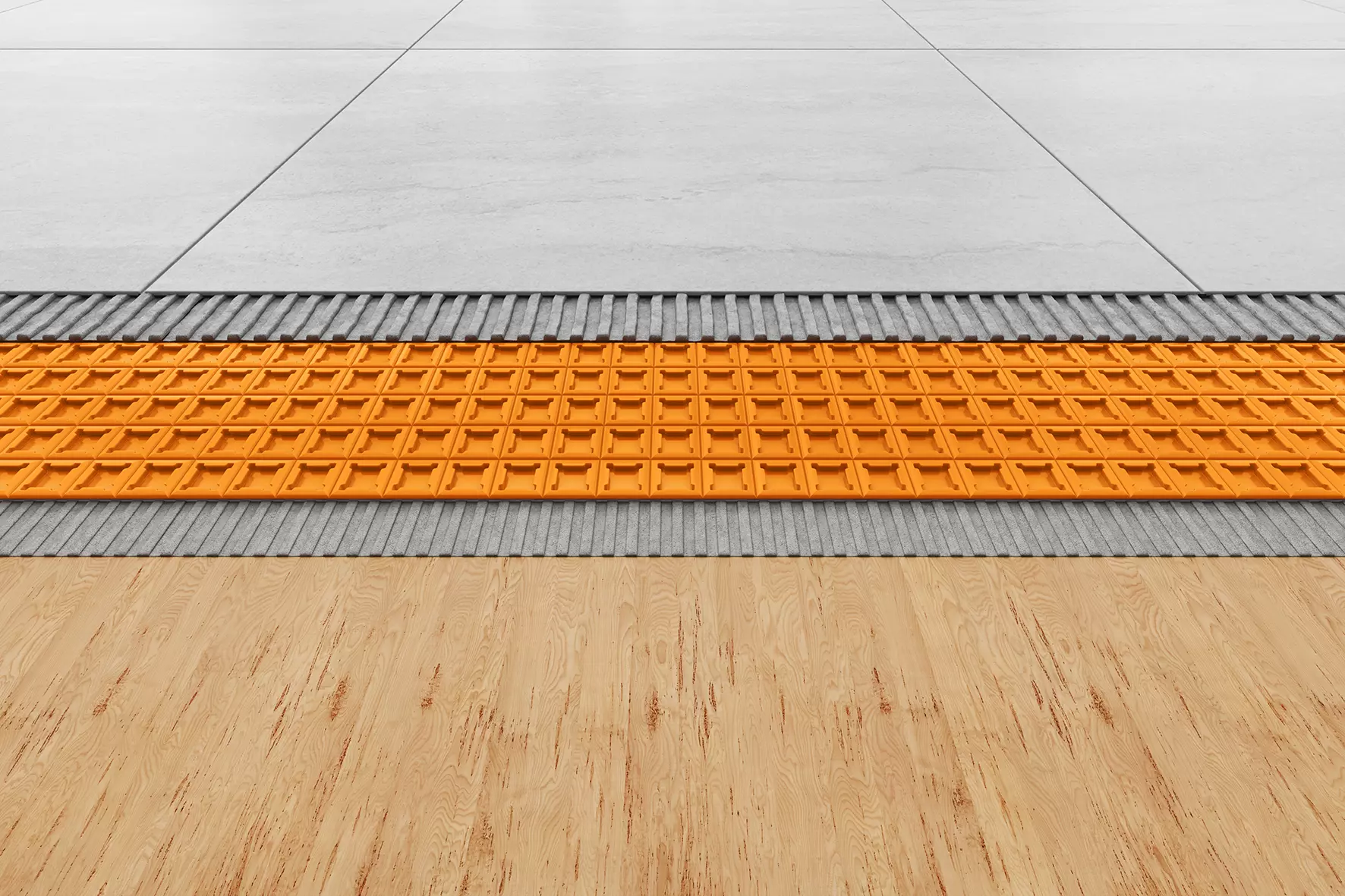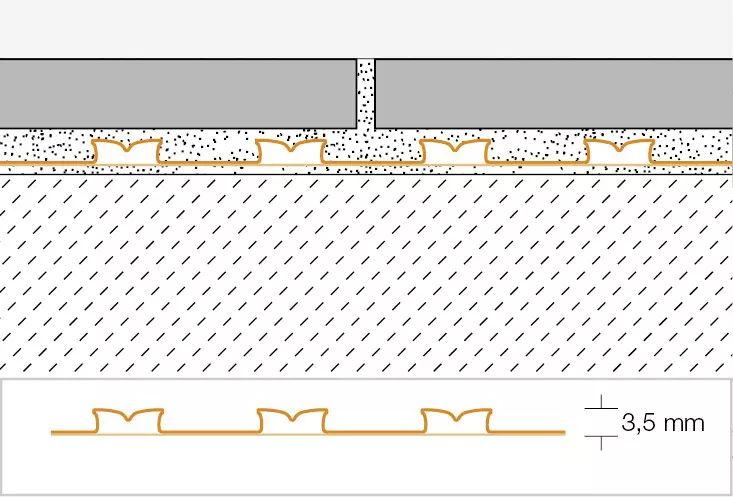- The substrate must be free of anything that could inhibit adhesion, level and load-bearing. Any necessary levelling work must be completed before DITRA is installed.
- The selection of the adhesive to be used with DITRA depends on the type of substrate. The adhesive must bond with the substrate and mechanically key into the DITRA anchoring fleece. A dry setting thin-bed mortar can be used for most substrates. It is advantageous for the thin-bed mortar to have a consistency suitable for fluid beds. Any potential material incompatibilities should be checked beforehand.
- The thin-bed mortar should be applied to the substrate with a notched trowel (recommended size: 3 x 3 mm or 4 x 4 mm; mortar requirement approx. 1.5 kg/m²).
- The DITRA sheets, once cut to size, should be embedded over the entire surface of the anchoring fleece into the already applied mortar. Now use a float or pressure roller to immediately press them into place, working in a single direction. An orbital sander can also be an effective tool. The curing time of the mortar must be observed. It is helpful to align the DITRA accurately as soon as it is laid and to lay it under a slight tension.
The EasyCut gridlines significantly reduce the restoring forces of the mat.
The availability of a second person can facilitate installation. The individual mats are laid so as to abut against one another.
Note: If DITRA is to be used for uncoupling in addition to waterproofing, abutting joints and connections to associated system components must be reworked. Further information is given in the notes on waterproofing.
The same applies if using DITRA on green substrates in conjunction with coverings that are susceptible to discoloration.
- To prevent damage to the laid DITRA mat or its becoming detached from the substrate, we recommend that you protect the area from mechanical stresses, e.g. by laying out running boards (particularly in areas used for transport of materials). Special protective measures may likewise be necessary for outdoor installations, e.g. to shield against direct sunlight or precipitation. Remove any water that may have accumulated in the dimpled recesses before applying the thin-bed mortar.
- Immediately after fitting the DITRA mat, tiles can be installed using the thin-bed method, using a thin-bed mortar appropriate to the requirements of the covering. The notch size of the trowel must be matched to the tile format. Observe the curing time of the thin-bed mortar. The tiles should mostly be fully embedded in the mortar. Particularly for coverings subjected to high mechanical stresses or in outdoor areas, the tiles should be in contact over their entire areas and in accordance with the technical regulations.
Note: The square indentations can be filled using the smooth side of the notched trowel (mortar requirement approx. 2.0 kg/m2) and the thin-bed mortar can then directly be grooved with the (correctly sized) notch, in a single work step. Depending on the tile size or the site conditions, it may alternatively be more effective to first fill the indentation with the tile adhesive used for the installation. Tile installation can begin once the trowelled surface is firm enough to walk on. Note that the substrate must be free of dust prior to installation. If necessary, vacuum the substrate prior to installation or apply a primer in case of doubt.
Any potential material incompatibilities should be checked beforehand. If using covering materials with a side length exceeding 30 cm, we recommend a fast-setting tile adhesive with crystalline water binding to facilitate the rapid strength development and drying of the mortar.
- Follow the instructions in this data sheet and the other technical regulations when installing movement joints for perimeter, edge or connection joints.
Waterproofing with Schlüter-DITRA
DITRA can be used to provide certified waterproofing in conjunction with tile coverings, provided that the abutting mat joints and the connections to installed components and upright structures are carefully sealed. DITRA can be used in accordance with the waterproofing standards 18531-5 and 18534 applicable in Germany. Water exposure classes: W0-I to W3-I. DITRA also features the national technical approval (abP) required in Germany.
System-certified thin-bed mortars only must be used in areas that require compliance with the certificate of technical approval (abP). For further information about thin-bed mortars and the corresponding technical approval certificates, please contact us at the address provided on this data sheet. We recommend the use of our Schlüter-KERDI waterproofing membrane (see product data sheet 8.1 Schlüter-KERDI) for load class B, 'Swimming pools'.
DITRA thus protects the substrate from damage caused by permeating moisture and aggressive substances. To join the mats, trowel Schlüter-KERDI-COLL-L sealing adhesive over the abutting joints and cover them completely with Schlüter-KERDI-KEBA seaming tape in a minimum width of 12.5 cm.
To waterproof floor-to-wall transitions, apply KERDI-KEBA tape to DITRA on the floor and directly onto the substrate in the wall areas in the appropriate width.
The sealing tape should have a coverage of at least 5 cm.
KERDI-KEBA can also be used to create functional connections to fixed structural components such as door and window frames and to balcony edge profiles in metal, wood or plastic. The first step is to apply Schlüter-KERDI-FIX to the adhesive surface of the structural components.
The remaining width is then affixed over its entire area to DITRA using KERDI-COLL-L.
The suitability of KERDI-FIX for the materials of the structural components must be verified in advance.
Separate the DITRA at existing movement joints or structural movement joints and seal the abutting joints with KERDI-FLEX.
KERDI-FLEX should also be used with flexible edges. KERDI-KEBA can also be used here as an alternative, by forming an appropriate loop.
Note on floor drains
Schlüter-KERDI-DRAIN and Schlüter-KERDI-LINE are specially developed drainage systems for linking to bonded waterproofing assemblies. DITRA can be quickly prepared for this quickly and reliably, in conjunction with KERDI collars.
Substrates for Schlüter-DITRA
The substrates on which DITRA is to be installed must be thoroughly checked for suitability, e.g. that they are level, load-bearing, clean and compatible with the materials used. Remove any surface components that could weaken the bond. Any levelling, height adjustment or slope compensation must be carried out before DITRA is laid.
Concrete
Concrete is prone to long-term structural deformation due to shrinkage. In addition, deflection in concrete and pre-stressed concrete can cause tensions to occur. Since the resultant tensions between the concrete and the tile covering (in walls and floors) are absorbed by the use of DITRA, tiles can be laid as soon as the concrete is ready to bear weight.
Cement screeds
The applicable regulations require cement screeds to have cured for at least 28 days prior to tile installation and have a moisture content below 2 CM%. Floating and heated screeds in particular also have a tendency to deform and crack later, e.g. due to mechanical stresses or temperature fluctuations.
With DITRA, tiles can be laid on green cement screeds as soon as they are firm enough to be walked on.
DITRA neutralises cracks and screed deformations that occur later and prevents them from affecting the tile covering.
Gypsum based screeds
Under the applicable regulations, calcium sulphate (anhydrite) screeds may have a maximum residual moisture level of 0.5 CM% at the time of tile laying. In contrast, with the use of DITRA, the tiles can be laid at residual moisture levels of less than 2 CM%.
If necessary, the screed surface should be treated (grinding, priming) as specified by the technical regulations and manufacturer instructions. DITRA can be affixed with dry-setting or other suitable thin-bed mortars. The DITRA protects the screed surface from permeating moisture. Calcium sulphate-based screeds are susceptible to moisture, so must be protected from further damp, e.g. moisture loads from beneath.
Heated screeds
DITRA can be used on heated screeds, provided that the notes given above (on cement and calcium sulphate) are observed. Coverings created with DITRA can be heated just 7 days after completion. Starting from a temperature of 25°C, the supply temperature can be increased by a maximum of 5°C per day up to a usage temperature of max. 40°C. The air channels formed by the DITRA mat allow rapid and even heat distribution under the tile covering.
Note:
For floor heating systems, we recommend our Schlüter-BEKOTEC-THERM system as a ceramic thermal comfort floor.
DITRA is also highly suitable for uncoupling in conjunction with floor heating systems based on thin electric heating mats. In such cases the DITRA can be placed either above or below the heating mat. However, a better uncoupling effect is obtained by placing it above the heating mat.
Schlüter-DITRA-HEAT, a special uncoupling mat, has been developed to accommodate the heating cables of floor and wall heating systems (see product data sheet 6.4).
Dry screeds
When fitting DITRA, once dry screed elements have been correctly installed according to manufacturer instructions, you can choose the maximum tile format in any size.
Masonry or mixed substrates
Fully jointed brickwork, sand-lime bricks, cement blocks, aerated concrete and similar materials are generally compatible substrates for DITRA. Uneven areas must be levelled in advance. In restoration and remodeling projects, substrates frequently consist of different materials (mixed masonry), which have a tendency to crack at the interfaces with other materials due to different deformation rates. DITRA protects the tile covering from the resultant tensions and cracks.
Gypsum plaster and bricks
Gypsum substrates should be inspected and found to be dry in accordance with the relevant regulations. If necessary, the surface should be pre-treated with a primer. DITRA can be affixed using dry-setting or other
suitable thin-bed mortars.
Balconies and terraces
As an uncoupling mat, DITRA neutralises the tensions between the substrate and tile covering that can be caused on balconies by frequent, significant temperature fluctuations. In addition, for cantilevered balconies or terraces in contact with the ground that are subject to the movements of people only, DITRA can provide the sole waterproofing element in conjunction with the tile covering (the notes on waterproofing should be observed). In such cases the substrate (concrete or screed) must have a sufficient slope.
If previous coverings are sufficiently load-bearing and have the necessary slope, the existing assembly can be used directly as the substrate in renovation projects. Otherwise, loose or insufficiently bonded parts must be removed prior to attaching DITRA and any flaws or lack of slope must be corrected with a suitable ready-mix mortar.
The use of Schlüter-DITRA-DRAIN is recommended for coverings with dimensions exceeding 30 x 30 cm (see also product data sheet 6.2).
Roof terraces
With roof terraces situated above residential/utility and other spaces as well as roofed areas, installation should first be – in accordance with the applicable building regulations for roof assemblies – as a flat roof.
In case of heat-insulated residential or utility spaces (and other areas in which temperatures are anticipated to be different to those outside), a standard vapour barrier and top waterproofing layer are required. Any national standards and/or relevant codes that may deviate from this must be observed. A drainage system (Schlüter-TROBA or Schlüter-TROBA-PLUS) must be arranged over the top waterproofing. A screed is laid on top of this as the load distribution layer. DITRA is attached on the screed surface as an uncoupling for the tile covering and to protect the screed from moisture. As an uncoupling mat, DITRA neutralises the tensions between the substrate and tile covering that can occur on terraces due to frequent, significant temperature fluctuations.
The use of DITRA-DRAIN is recommended for coverings with dimensions exceeding 30 x 30 cm (see also product data sheet 6.2).
Vinyl coverings and coatings
All surfaces must be load bearing and must be suitable or pre-treated for bonding with an appropriate adhesive in which the DITRA anchoring fleece can be embedded. The compatibility of the adhesive with the substrate and with DITRA must be verified in advance.
Chipboard and compressed wood panels
These materials are prone to particularly severe deformation under the influence of moisture (or fluctuations in air humidity). Any chipboard and compressed wood panels used should therefore be impregnated with water-repellent. These panels can generally be used as a substrate for floors and walls in interior spaces. However, the panels must be thick enough to be sufficiently stable in combination with a suitable support assembly. They should be secured with screws placed suitably close together. Joints should be of a tongue-and-groove type and must be bonded with adhesive. Edge joints of about 10 mm should be maintained to adjacent structural elements. DITRA neutralises any tensions with the tile covering and also prevents permeating moisture.
Hardwood floors
Ceramic coverings can generally be laid directly on sufficiently load-bearing, screw-fastened hardwood floors with tongue and groove joints. The wooden substrate should have reached the equilibrium moisture content before the DITRA is laid. It has proven beneficial here to lay an additional layer of chipboard or compressed wood panels. Before this, uneven floor surfaces should be levelled by suitable measures.
Mastic asphalt (bitumen) screeds
With DITRA, ceramic tile coverings can be laid on load-bearing, standard compliant, unheated asphalt screeds in indoor areas. Surfaces must be sanded or otherwise suitable for sufficient bonding of the thin-bed mortar with DITRA.


